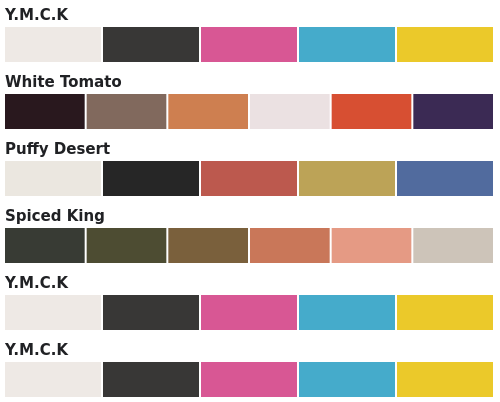palette-aldente v1.14.0
Palette Aldente 🍝
Introducing the ultimate color palette companion: Palette Aldente alˈdɛnte! Curate your favorite color schemes and share them effortlessly.
- Makes sure your
ymlorjsonis actually valid - Exports it to JSON
- Provides a handy JS wrapper that works everyhere. (Node, Browser, Codepen etc..)
- Exports a static SVG of all the palettes
- Exports PNG images of each palette.
- Provides a HTML templete with all the palletes. (Ideal for github pages)
- Ability to name your colors and palettes automatically
- Coverts almost any color format to any other.
- Possibility to additionally convert to different color formats: lab, lch, oklab, hsl, etc...
- Exports Palettes for Photoshop, Illustrator, Gimp, Sketch whatever you can dream of.
Open-sourcing your color palettes allows others to use and improve them, helps build your design expertise, and fosters collaboration within the community. This tool was built to make the process as easy and streamlined as possible.
Quickstart
npx palette-aldente ./src/palettes.yml --formats name,rgb,hsl --namelist bestOf --palettefiles aseUse to publish your palettes
npm install palette-aldente --save-dev- Create a
jsonorymlfile containing your colors. - Edit your
package.jsonto build your actual palette ex:
//...
"scripts": {
"build": "palette-aldente ./yourcolors.json",
}npm run buildto build the project.- Find your build in the
dist/folder. - Optionally use this workflow to automatically publish all changes to github pages.
CLI Manual
$ npx palette-aldente ./mypalettes.yml
$ palette-aldente --help
Usage: palette-aldente [options] <file>
Usage: palette-aldente [options] <file>
CLI to manage color palettes
Arguments:
file path to input yaml or json file
Options:
-V, --version output the version number
-O, --out <directory> path to output directory (default: "./dist")
-A, --autoname <boolean> if true, the palette name will be generated from the colors contained (default: true)
--no-autoname unnamed palettes will be have "Untitled <n>" as name
-F, --formats <string> comma separated list of formats to convert to
-D, --defaultformat <string> default color format outputted in your target file (default: "hex")
-N, --namelist <string> specify color name list to use to name colors on export (default: "bestOf")
-S, --svg <boolean> export an overview SVG of the palettes (default: true)
--no-svg do not export an overview SVG of the palettes
-J, --js <boolean> export a JS wrapper file with the palettes an a minimal API (default: true)
--no-js do not export an JS file
-H, --html <boolean> export a HTML file that showcases the palettes (default: true)
--no-html do not export an HTML file
-I, --img <boolen> export PNG images of the palettes (default: true)
--no-img do not export PNG images of the palettes
-P, --palettefiles <string> comma separated list of palette files to export (default: false)
-h, --help display help for commandA collection of color palettes I want to reuse. Feel free to clone this and use it to create your own palette library
Build
- Edit your palettes in palettes.yml
- Install all things that are needed to build your palette. (
npm ci) - Run
npm run build(Check the console output for eventual error) - Enjoy your files in the
dist/folder
Use
To use this in your JS code import or include dist/palettes.js. It exposes the following props:
palettesan array of objects containingname(string with the palette name) andcolors(an array of hex values as strings)get(paletteName)will return an object of the palete with a given namerandom()returns a random paletteaddPalettes(object)merges in new palettes
Publish
Github Pages
By default, palette-aldente exports an HTML file that you can publish on github pages. To do so automaically whenevery you edit your palette file, you can copy (this workflow](https://github.com/meodai/palette-aldente/blob/main/.github/workflows/node.js.yml) to your own .github/workflows/ directory or simply use the "actions" tab on your repository.
After the workflow successfully passed, make sure to turn on "Pages" in your github repository (settings > pages).
NPM
If you want to reuse your palettes in ofther prjects you might want to use NPM to publush them.
Just add the following to your package.json
"main": "dist/palettes.js",
"type": "module", "exports": {
"import": "./dist/palettes.esm.js",
"require": "./dist/palettes.js"
},after that you can import your palettes easily:
import { colorPalettes } from "omorovdcolors";
// or
import { colorPalettes } from "https://cdn.skypack.dev/somorovdcolors@1.0.1";Used by
Example PNG Export

Example SVG Export
2 years ago
3 years ago
3 years ago
3 years ago
3 years ago
3 years ago
3 years ago
3 years ago
3 years ago
3 years ago
3 years ago
3 years ago
3 years ago
3 years ago
3 years ago
3 years ago
3 years ago
3 years ago
3 years ago
3 years ago
3 years ago
3 years ago
3 years ago
3 years ago

